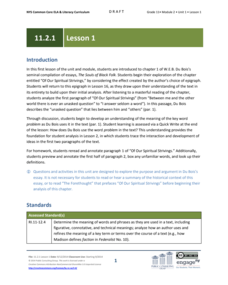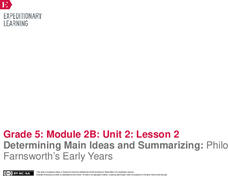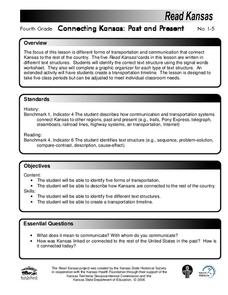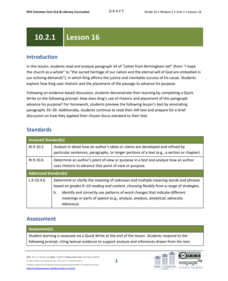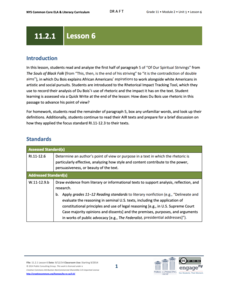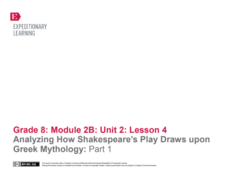EngageNY
Building Background Knowledge: Vietnam as a “Battleground in a Larger Struggle”
Read. Stop. Think. Scholars use a reading strategy to process the challenging text, "The Vietnam Wars." They read a paragraph and then stop to think about the text and its meaning. Readers then go on to work with partners and make notes...
EngageNY
Using Routines for Discussing A Long Walk to Water and Introducing Juxtaposition (Chapters 9 and 10)
Take a stand. Scholars consider what it means to take a stand in A Long Walk to Water. They complete an activity by taking a stand and moving to a labeled section of the room that matches their opinion. Readers then examine text features...
EngageNY
Reading for Gist and Answering Text-Dependent Questions: Chapter 4 of World without Fish
True or false? Scholars read chapter four of World without Fish and explore the idea of a myth. They discuss in triads the meaning of the myth of nature’s bounty. Learners annotate the text on sticky notes and then answer text-dependent...
EngageNY
Tracing the Idea of Fish Depletion: Chapter 2
Scholars read chapter two of World without Fish to learn more about the fishing industry. Learners discuss in triads what it means for fishing to become an industry. They then write the gist of pages 28-33 on sticky notes and answer...
Curated OER
Reading Worksheet
In this reading worksheet, students read a given portion of a book, summarize the information, select vocabulary words, write questions and answers about the reading, and draw an illustration of their favorite part. Students complete...
Curated OER
Calculator Tricks: The Golden Prediction
Excite the class with a mathematical trick, a calculator, and a good number sense. They use the directions provided on each slide to make a list of numbers, use their calculator to divide, and find the golden mean. A little history on...
Curated OER
Express Yourself
First graders identify details that make reading and writing more interesting. They classify events, people, places, and things and attach specific characteristics to each one. Everyone generates describing words on a worksheet that's...
EngageNY
Grade 11 ELA Module 2: Unit 1, Lesson 1
When is a word more than just a word? Scholars examine the significance of a word used by W.E.B. Du Bois in "Of Our Spiritual Strivings." Readers carry out a deep discussion of the use of the word problem in the text. After sharing ideas...
Curated OER
Math: Navigating the World Around Me
Young mathematicians research and discuss real world math word problems and ways in which they apply math concepts in their everyday lives. They create a storyboard of a math word problem from which they create a slide for a multi-media...
Curated OER
Singing a round
Kids use their hands, bodies, and voices to explore the musical concept of a round. They say vegetable words while stomping and clapping out a rhythm in unison and then in a round. They then sing a round while maintaining a steady beat....
Curated OER
Vocabulary Review: Government Terms
As your English language pupils learn about the government and vocabulary words commonly used when talking about the government, present them with this worksheet. There are eight multiple choice questions, and each vocabulary word is...
EngageNY
Grade 11 ELA Module 1: Unit 2, Lesson 13
What impact does word choice have on character development? Using the resource, scholars read Act 3.1 from Shakespeare's Hamlet, focusing on the development of Ophelia's character. They also complete a Quick Write to analyze the meaning...
EngageNY
Analyzing a Thematic Concept: The Invisibility of Captives during WWII (Pages 182-188)
Readers complete a word web-based on the word dignity. They use their Understanding Invisibility note catcher to discuss how dignity relates to the theme of invisibility. After group discussion comparing invisibility and loss of dignity,...
EngageNY
Reading for Gist and Answering Text-Dependent Questions: Industrial Food Chain
Where do humans fall on the food chain? Scholars read about the Industrial Food Chain in The Omnivore’s Dilemma sections. They use word catchers to record unfamiliar words as they read and place sticky notes in the margins to annotate...
EngageNY
Determining Main Ideas and Summarizing: Philo Farnsworth’s Early Years
Teamwork makes the dream work! Learners work in groups to analyze pages 2-9 of The Boy Who Invented TV, The Story of Philo Farnsworth. They complete a first read to determine the gist and a second read to identify main idea and provide a...
Curated OER
Connecting Kansas: Past and Present
Upper graders identify five forms of transportation and describe how Kansans are connected to the rest of the country using transportation and communication. They complete a graphic organizer for each type of text structure given to them...
Curated OER
Understanding the Poem
Practice literary analysis with your poetry pupils using the mysterious narrative poem "The Listeners." They examine the archaic language and answer 12 comprehension and analysis prompts. Foster creativity with these referential...
EngageNY
Grade 10 ELA Module 2: Unit 1, Lesson 9
How did Martin Luther King Jr. establish tone in his writing? Scholars analyze King's tone and discuss how he changes and refines his claim in "Letter from Birmingham Jail." They also define new vocabulary words, respond to a writing...
EngageNY
Grade 10 ELA Module 2: Unit 1, Lesson 16
Take your place in the world—or the text. Scholars look at how the placement of a particular paragraph adds to the meaning of "Letter from Birmingham Jail" by Martin Luther King Jr. Before working on a quick write activity; readers...
EngageNY
Grade 11 ELA Module 2: Unit 1, Lesson 6
Take a look at the world through my eyes. Readers begin to understand the techniques Du Bois uses to advance his point of view in the fifth paragraph of the chapter "Of Our Spiritual Strivings." They complete a Rhetorical Impact Tracking...
EngageNY
Analyzing Poems from Inside Out and Back Again to Develop Criteria for an Effective Poem
Scholars analyze a model poem to help guide their poetry writing. They use Think-Pair-Share to discuss word choice and meaning in "Papaya Tree" and "Wet and Crying." To finish, they use their discussions to collect evidence on what makes...
EngageNY
Analyzing How Shakespeare’s Play Draws upon Greek Mythology: Part 1
Scholars read the story "Pyramus and Thisbe," analyzing word choice, tone, and meaning. They then try to find the gist of the story and discuss how Shakespeare used the myth in his play A Midsummer Night's Dream.
EngageNY
Introducing a Thematic Concept: Becoming Visible Again after Captivity
Share your thoughts. Scholars use Think-Pair-Share to answer questions related to Louie in Unbroken. The class completes the Becoming Visible Again anchor chart to understand the text's theme better. They write an example of Louie...
EngageNY
Analyzing an Author’s Craft: Carlotta’s Journey to Justice
What's an appropriate response? Scholars open the text A Mighty Long Way to see how Carlotta responded to racism, discrimination, and abuse. They work in pairs to answer questions regarding her responses. To finish, they use the Dignity...
Other popular searches
- Compound Words Meanings
- Words With Double Meanings
- 10 Compound Words Meanings
- Words With Similar Meanings
- Root Word Meanings
- Matching Words and Meanings
- Figurative Meanings of Words
- Identify Meanings of Words
- Denotative Meanings of Words
- Locate Meanings of Words
- Matching Words With Meanings
- Words With Different Meanings









